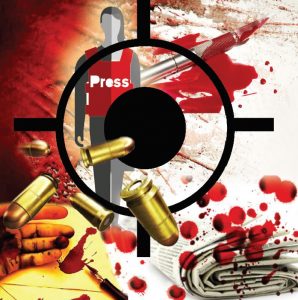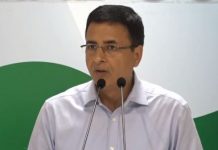 At this juncture, we don’t have to allow the brutal murders of independent voices like Shujaat Bukhari and Gauri Lankesh to instill fear in the minds of independent journalists and thinkers. The killings have left a clear message: stand up for what you believe in, fight out relentlessly regardless of the consequences. The untimely killing of the fiercely independent journalists is certainly an attack on the freedom of press. The World Press Freedom Index compiled by Reporters without Borders mentions that journalists were increasingly targets of online smear campaigns and threats while “Prosecutions are also used to gag journalists who are overly critical of the government.” It is high time the government reassures journalists and comes out with a legislation providing foolproof protection to journalists.
At this juncture, we don’t have to allow the brutal murders of independent voices like Shujaat Bukhari and Gauri Lankesh to instill fear in the minds of independent journalists and thinkers. The killings have left a clear message: stand up for what you believe in, fight out relentlessly regardless of the consequences. The untimely killing of the fiercely independent journalists is certainly an attack on the freedom of press. The World Press Freedom Index compiled by Reporters without Borders mentions that journalists were increasingly targets of online smear campaigns and threats while “Prosecutions are also used to gag journalists who are overly critical of the government.” It is high time the government reassures journalists and comes out with a legislation providing foolproof protection to journalists.
According to the latest World Press Freedom Index published by Reporters Without Borders, India ranked 138th among 180 countries. India’s ranked 136th in 2017 and 133rd in 2016. Actually in the World Press Freedom Day, India slipped two points on the World Press Freedom Index ranking. The report has been compiled by Reporters Without Borders (RWB), one of the world’s leading independent organizations dedicated to promoting and defending freedom of information. The RWB has network of active correspondents in over 150 countries and it strives daily to maintain a free press in every corner of the globe. Registered in France as a non-profit organization, it has consultant status at the United Nations and UNESCO.
The 2018 World Press Freedom Index reflects growing bitterness towards journalists. The antagonism towards the media which is openly encouraged by political leaders poses a great threat to democracy. The RWB publishes the World Press Freedom Index each year since 2002 and it measures the level of press freedom available to journalists and the quality of journalism in 180 countries. The parameters to determine the ranking include media independence, transparency, legal framework and environment and self-censorship. India slipped two ranks on the 2018 index 138 from 136, one spot below Myanmar and one spot above Pakistan. Norway topped the list while North Korean stood at bottom at 180. A major reason for India’s poor ranking is the killing of journalists in connection with their work. “At least three of the journalists murdered in 2017 were targeted in connection with their work. They included the newspaper editor Gauri Lankesh, who had been the target of a hate campaign on social networks. Three other journalists were killed for their professional activity in March 2018.” The RSF report says that “In India hate speech targeting journalists is shared and amplified on social networks and this hatred of journalism poses a threat to democracy.”
The Hoot, a non-profit media watchdog has also observed that “Media freedom continued to deteriorate in the first four months of 2018 in India. There were also around 50 instances of censorship and more than 20 instances of suspension of Internet services”. Before the killing of Shujaat Bhukhari, two Dainik Bhaskar journalists, Navin Nishchal and Vijay Singh were killed when their bike was hit by an SUV in Bhojpur in Bihar on March 26. A day later, a TV journalist, Sandeep Sharma died when a truck run over him in Bhind in Madhya Pradesh. It is learnt that Sharma had done a sting operation on a sand mining mafia in Bhind. He had told police beforehand that he feared threat to his life.

The daylight murder of Bukhari has become Kashmir’s make or break moment with BJP already withdrawing support to Mehbooba Mufti government. Shujaat Bukhari held an independent opinion on the conflict in Kashmir and how it could be resolved amicably. The killing in the heart of Srinagar has caused widespread damage to the normalization process in Kashmir. Fingers are being pointed to country’s poor ranking on the press freedom index which is just one point above Pakistan. Bukhari had built goodwill for him and credibility for media that he worked for. He was a prominent advocate of the ceasefire. Whosoever chose to kill him would have been aware of the consequences of his killing. Over the years, Bukhari earned for himself a name as the editor and founder of Rising Kashmir and as correspondent of The Hindu. The mindless murder is an attempt to block out the truth by attacking an important institution of democracy. The Fourth Estate. Shujaat was a fearless journalist who advocated peace in Kashmir and it did not find favour with Pakistan and militant organizations. It has always been a tight ropewalk for journalists in Valley because terrorist outfits have no respect for freedom of speech and expression. The killing of journalist Shujaat Bukhari and journalist-activist Gauri Lankesh by unidentified assailants have saddened media fraternity and the protests across the nation are indicators that it was nothing short of murder of a voice of dissent. Angry reaction to the killings shows how people stood up for Shujaat Bukhari and Gauri Lankesh, who held a dissenting view on variety of issues, a sign of vibrant democracy, their right to express opinions. Karnataka Police has finally claimed to have cracked the Gauri Lankesh murder case. A frail activist-journalist had antagonised many with her anti-establishment stance and secularism which led to her death. However, the police lost precious time in unravelling the murder of Gauri’s ideological fellow traveller MM Kalburgi three years back. In both Gauri Lankesh and Shujaat Bukhari cases, t is the network of masterminds and puppeteers that needs to be unravelled.
The murders of journalists have reignited the debate on freedom of the press and the freedom of speech in the country. Among the major economies of the world belonging to the G-20 group, India has witnessed the fourth highest number of such killings related to journalistic work, behind Mexico, Russia, and Brazil. Most journalists who have been murdered for their work covered politics and corruption. Another community which has been targeted is that of Right to Information (RTI) activists. About 70 RTI activists have been killed in India so far since the act was passed in 2005, and hundreds have faced assault. Death is the ultimate price journalists, writers, and whistleblowers pay for challenging powerful vested interests or for expressing dissent. It is time there is a national debate on the precarious freedom of press.
| Online abuse: Silver lining that isn’t for female journalists
Escaping the wrath of online abusers for the female journalists and bloggers around the world has become invariably inevitable who wear heroism on sleeves while risking their lives to report the truth. The classification of online harassment’s that are meted to women journalists from other side of the screens of social media platforms begins from hurling abuses, naming, slut shaming, death threats, rape threats, circulating morphed pornographic pictures/videos, imposter accounts to circulate false information, doxxing, trolling, hate speech, bigotry, etc. Such vehement online attacks on the female journalists and writers cannot be called as the manifestation of gender discrimination or sexuality, instead, a direct attack on the freedom of press and expression to silence voices that represent them. However, this cannot be denied that female journalists are three times susceptible to online abuses than male counterpart. The UN Human Rights Council Resolution L.13, on the promotion, protection and enjoyment of human rights on the Internet, strongly affirms that “the same rights that people have offline must also be protected online, in particular freedom of expression, which is applicable regardless of frontiers and through any media of one’s choice, in accordance with articles 19 of the Universal Declaration of Human Rights and the International Covenant on Civil and Political Rights.” Female journalists and writers in South Asia have since ages been under constant threat of life, sexual harassment and violation of human rights for expressing opinions freely — be it offline or online. The hit list of online victims from India has names like Barkha Dutt, Patricia Mukhim, Rana Ayyub, Nidhi Razdan, Sagarika Ghose, Dhanya Rajendran, Masrat Zahra (Photojournalist from Kashmir). Besides India, Gul Bukhari from Pakistan, Taslima Nasreen (author) from Bangladesh, Shammi Haque (blogger) from Dhaka. Recently, within days of the murder of noted Kashmiri journalist Shujaat Bukhari, consulting editor at Times of India, Sagarika Ghose, faced death threat on Facebook. On June 23, an ICICI bank official name Karan Bir Singh posted Ghose’s image with a death threat message: “This is the journalist that should get shot. Not the likes of Bhukhari (Shujaat Bukhari).” Then in April this year, independent journalist and author Rana Ayyub became the victim of one of the biggest doxing scandals when malicious tweets from a Twitter handle bearing her name and image were widely circulated to represent her as the sympathizer of child rapist in Kathua rape-murder case. One of the tweets read: “Minor child rapists are also human, do they have no human rights. This Hindutva Government is bringing ordinance for death to child rapists just to hang Muslims in larger numbers. Muslims aren’t safe in India anymore”. Rana, explaining her harrowing account in a criminal complaint filed on April 26 said: “I couldn’t sleep for three nights. I couldn’t talk, I couldn’t believe what was happening. I was numb. My parents called me to see if I was OK. The trolls posted my phone number, the address of my house online. If this is the depth of their hatred, what will stop them from coming into my house as a mob and kill me?”… “I’ve been trolled before, but I have never faced anything like this. I don’t know what else I have to fear after this… I’m repeatedly telling the state that I’m under attack and I fear for my safety. Will they take action only after something happens?” Senior Indian Journalist Barkha Dutt too talked about receiving death threat, “Received chilling veiled threats and “messages” from powerful people in the Establishment today that my family and I are under surveillance — and that I will be smeared & maligned to stop me from starting any new projects. Was advised to get my house debugged. Is this my country?” Another incident like in the case of Dhanya Rajendran, editor-in-chief, The News Minute, was asked to upload nude videos and perform sex acts with her supporters. The reason was a critical opinion by Rajendran on film Sura. A hashtag #PublicityBeepDhanya was run on Twitter to troll her that lasted for three days and pulled over 30,000 abusive tweets. Then, Famous TV journalist at NDTV, Nidhi Razdan, has received death threats on many occasions and to count in, recently on Instagram via a private message, a platform mostly known for photo stories. Journalist Sandhya Ravishankar for her sand mining story from Tamil Nadu, investigative journalist Neha Dixit for child trafficking in Assam, BuzzFeed India editor Rega Jha for her opinion, the list is never ending. Again, female photojournalists are often subjected to abuse and hostility both on the ground and online. And if she is a Muslim, reporting from a conflict or encounter site then the gravity of abuse is even more. This is what happened when budding photojournalist from Kashmir, Masrat Zahra, was called Mukhbir (spy) by online offenders for being sighted at a conflict site while taking pictures at the encounter site. Masrat then took to Facebook to share her ordeal, “Last night, I uploaded my picture from a gun battle site and within no time people circulated it on their pages and walls with the caption ‘MUKHBIR’ (spy). This is really shocking, that fateful day I was seriously injured my leg and shoulder got serious injuries despite that I did my job and clicked pictures with a broken arm, even my trousers were torn off, and now it has been one and a half month still I am not recovering.” Dealing with trolls
In 2013, a study on verbal and online abuse in India called ‘Don’t Let It Stand’ mentioned that in some cases, a person uses multiple accounts to harass a woman. Wikipedia defines such a phenomenon, in which multiple (Wikipedia) user accounts are used for inappropriate purposes as sock puppetry. In a volunteer-driven community dependent project like Wikipedia, volunteers use sock puppetry to derive support for their point of view, especially while editing an article that has contentious views by many people. The Organisation for Security and Cooperation in Europe, in its report released in February 2016 ‘New Challenges to Freedom of Expression: Countering Online Abuse of Female Journalists’, said that women journalists, bloggers and other media actors are “disproportionally experiencing gender related threats, harassment and intimidation on the internet which has a direct impact on their safety and future online activities.” On the occasion of International Women’s Day, March 8, 2017, famous journalist organisation International Federation of Journalists (IFJ), known as protector of freedom of press, started the Byteback Campaign calling the entire torchbearers of press freedom organisations to commonly fight to stop the steady trend of trolling, cyber-bullying, online harassment, etc. meted against the women journalists across the world. There is a need to create national discussions on the topic of online harassment and through Byteback Campaign, the organisation, IFJ, aims to achieve its campaign goals which are: ♦ Raise awareness on online harassment of women journalists in Asia-Pacific; In a Summit held in 2016, London, noted journalist Julie Posetti of Fairfax Media talked about dealing with online harassers and advised some tips to deal with them: ♦ Acknowledge the problem and take the impacts seriously. Extending her support she asked the representatives of press freedom to “Develop holistic strategies: involve cyber security staff, senior editors, editorial trainers, workplace health and safety teams, and social media editors in developing and disseminating online harassment policies and guidelines.” But, will these techniques help women journalists, bloggers to fight the crime of online harassment, the answers still remain. The rise of conservative governments across the world has to led to an increase in crushing of dissent and the restriction of the freedom of press. The harassment of journalists is mainly driven by political groups who loathe any kind of criticism. India, as an example, is witnessing a similar phase of an administration which encourages vicious trolling of female journalists. Police reports if filed are ignored and deliberately delayed, no action is taken against the abusers, partly because there are no concrete laws or the trolls somehow support a major political group so enjoy the support. Make laws for social media decorum and punish the guilty to the extent they fear doing the same thing again. Social media platforms like Facebook or Twitter should make stringent policies which discourages female harassment online, and suspend accounts which don’t fall in line. All we need now is action and an immediate stop to such immoral and unethical behaviour. |
letters@tehelka.com













